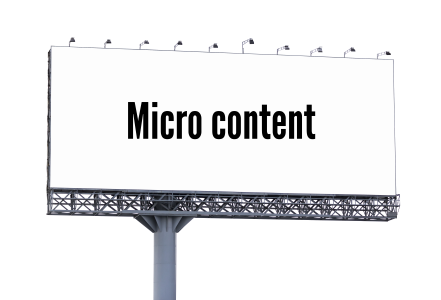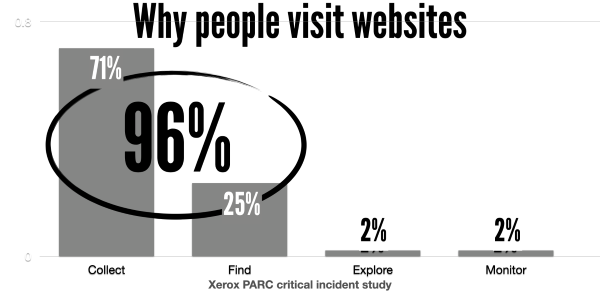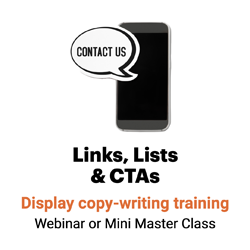Because ‘readers’ don’t read
I’m often amazed at the amount of energy writers put into perfecting the sentence structure in the fourth paragraph of their piece when those same folks toss off a headline in the 17 seconds before happy hour on a Friday afternoon.

The sad truth is, most of your readers will never read the fourth paragraph of your brilliant copy. But many more will read your display copy.
Here’s why:
1. They’re not reading; they’re looking.
Back in the day, web-usability guru Jakob Nielsen wrote one of the first articles on writing for the web. The headline:
How users read on the web
The first paragraph:
They don’t.
“People read paper,” writes T.J. Larkin, principal of Larkin Communications. “They use the web.”
Indeed, 96% of the time people visit your website, they’re looking for something specific, according to a Xerox PARC critical incident study.

They:
- Collect 71% of the time. They’re gathering multiple pieces of information — researching a webinar or blog post, maybe, or trying to find the best refrigerator for their tiny house.
- Find 25%. They’re looking for a specific piece of information, such as the address of a restaurant.
- Explore 2%. We used to call this surfing, or just browsing around the web.
- Monitor 2%. They might return to BBC.com, for instance, to keep up with the latest news.
That makes searching for information the No. 2 mobile task, according to Raluca Budiu and Jakob Nielsen, in User Experience for Mobile Applications and Websites. (No. 1 mobile task: killing time.)
What they’re not doing: reading. In fact, 79% of web visitors scan, according to Sun Microsystems research. Just 16% read word-by-word.

2. They don’t spend much time on your message.
One way we know they’re not reading: They don’t spend enough time with your message to read it.
How much time do they spend?
The average web page visit lasts a little less than a minute, according to 2011 research by the Nielsen Norman Group. (Often, visits last only 10-20 seconds.) That’s enough time, Nielsen figures, to read about 25% of each page.
“People spend less than a minute on content pages,” Nielsen writes, “even when they’re looking at long articles or detailed product specs.”
That’s the good news.
Make that 15 seconds. Some 55% of web visitors spent fewer than 15 seconds on the web pages they visited, according to a 2014 Chartbeat analysis of 2 billion visits across the web.
Filter purely for blog posts or article pages, and “only” 33% of web visitors spend less than 15 seconds on a page.
Figuring that people read about 200 words per minute, at 15 seconds per visit, that’s about 50 words per web page.
Make that 20% of the words on the page, according to research by four professors from two German universities. For the study, the professors fitted 25 European computer scientists, psychologists, sociologists, engineers and other highly educated professionals with eyetracking devices to use while they went about their daily lives.
They collected 50,000 page views, which were then analyzed by the Nielsen Norman Group. From that analysis NNG found that:

- On average, web visitors read half the information on web pages with 111 words or less.
- As the word count goes up, so too does the amount of time visitors spend on a page. But reading time doesn’t keep up with the additional word count. Web visitors spend only 4.4 seconds more for each additional 100 words. Assuming an average reading time of 200 words per minute, that’s only about 15% of the additional words.
- Web visitors spent enough time to read at most 28% of the words on a web page during an average visit. However, Nielsen says, they don’t spend all that time reading. It’s more likely, he estimates, that visitors read only 20% of the words on the average web page.
How much of your message are they really reading?
3. Their eyes are drawn to display copy
So which words are they reading?
People read the display copy. Eyes are drawn to:
That’s right. Most of the impact you make on your readers comes, not from the paragraphs itself, but from the display copy.
People look first at photos, headlines and links. Online, readers look at directional devices, such as navigational bars, links and teasers, first, according to The Poynter Institute’s Eyetrack07 study.
| Where readers look first | |||
| Broadsheet | Tabloid | Online | |
| Headlines | 53% | 7% | 8% |
| Photos | 37% | 78% | 3% |
| Navigation bars, links & teasers | 8% | 14% | 48% |
| Graphics | 2% | 0% | 25% |
| Ads | 0% | 0% | 16% |
| Catch readers where their eyes are People look first at photos, headlines and links, according to The Poynter Institute’s Eyetrack07 study. What they don’t look at first, second, third, fourth or fifth in any medium or vehicle: paragraphs. | |||
Readers of broadsheets (such as The New York Times) look at headlines first. Readers of tabloids (such as the New York Daily News) look at photos first.
Note what doesn’t make the list: Paragraphs.
How are using these primary entry points to pull readers into your message?
Display copy draws eyes in print. Here’s what readers “process,” or see, in print, according to “Eyes On the News,” a study by The Poynter Institute:
- Artwork: 80%
- Photos: 75%
- Headlines: 56%
- Briefs: 31%
- Captions: 29%
- Text: 25% (This number is actually high, the researchers said, because testing prototypes produce better numbers than real publications.)
There’s no doubt about it: The biggest ROI you’re going to get on your writing time and effort in any medium is the work you put into your display copy.
Make the most of your display copy.
With well-written display copy, you can:
- Draw readers in by pointing out interesting facts that can transform flippers and skimmers into readers.
- Break copy up, making it look easier to read. And the easier it looks to read, the more likely people will read it.
- Communicate to nonreaders by lifting your ideas off the page or screen.
- Help readers remember. Average students remember more from reading pieces that include “signaling” devices like display copy than from those that don’t, found reading researcher Bonnie J. F. Meyer in a 1979 study. Use this display copy superpower to cement your ideas in your readers’ heads, as well.
Do you have a system for reaching nonreaders with display copy? If not, how are you reaching the 79% of your visitors who don’t read paragraphs?

Ann, this is a great article that reinforces the problem with too much content on websites, but from the results of a study I just conducted with print information, some of the same problems exist: people don’t read print, either (at least not people ages 18-24, which were the respondents in a usability test). Skimming is their prefer mode of “reading.” Thanks so much for this article. I truly enjoyed it (and it’s important!). Deborah
Amen, Sister!